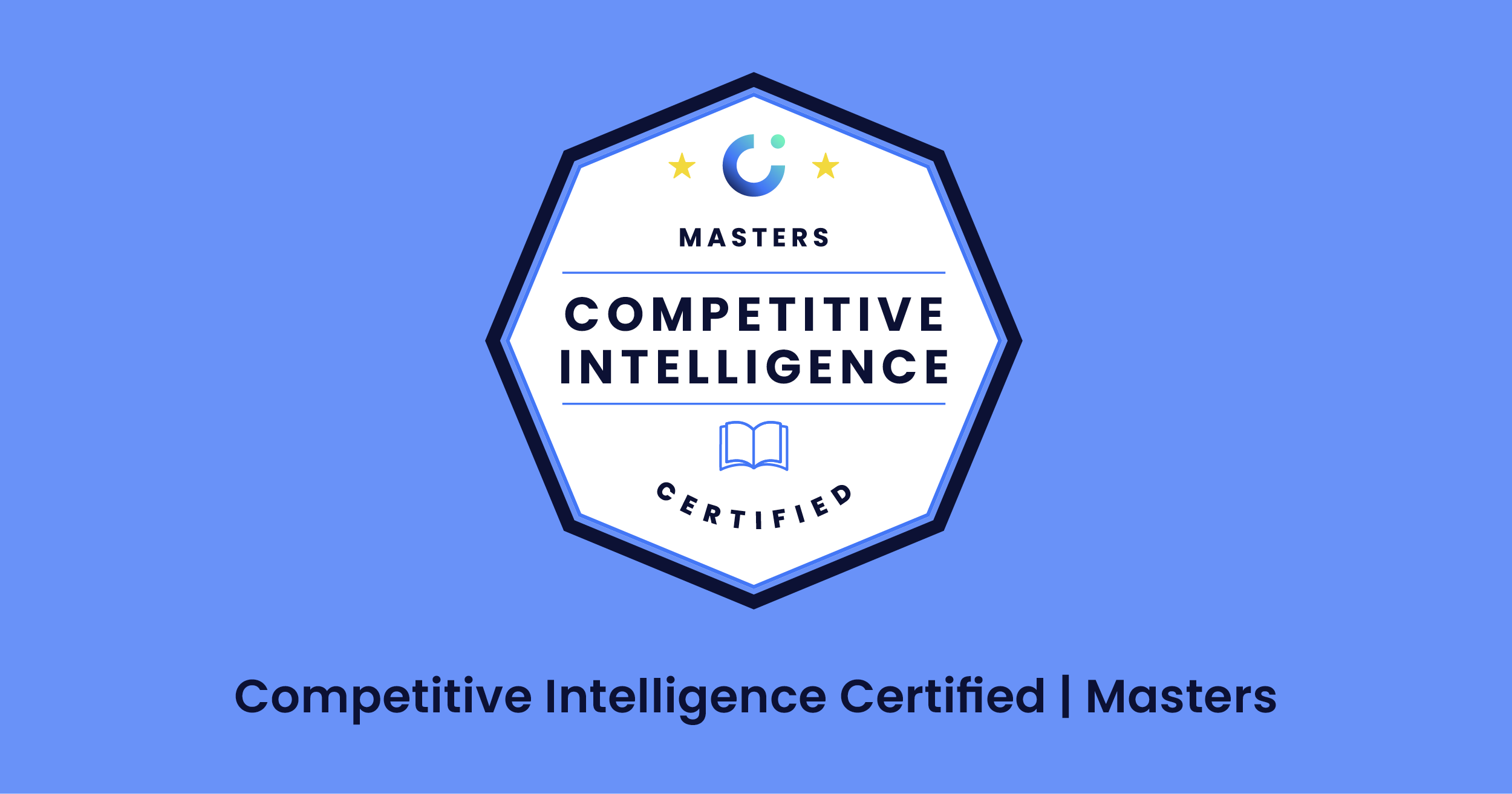What’s the role of social media in competitive intelligence?
If anyone has ever told you it’s negligible, don’t listen to ‘em. Social media is fertile ground for many a competitive intel pro. It’s simple, accessible, ethical, and fast. 💨
In this article, we’ll take you through the ins and outs of social media competitive intelligence and how to use it to get staggering results.
We cover:
- What social media competitive analysis is.
- Why and how social media works as an intel source.
- Exactly how to monitor competitors on social media, and what to do with that info.
- Social media's advantages over other CI sources.
What is social media competitive analysis?
Ever analyzed your competitors via social media? If you have, you’ve done a social media competitive analysis. Potentially without even knowing it. 😉
Thing is, social media is an incredibly powerful tool for gathering information on competing businesses. Used properly, you can follow and filter information according to your favorite strategic framework.
Or, you can just look to collect as much intel as possible, and save it for your next formal analysis.
Why social media competitive intelligence works
One of the first steps of any competitive intelligence program is figuring out who the competition actually are.
“Obvious!” you cry. Well, yes. But social media is great for this. It shows you which other vendors are active on the same talking points as you, on the same platforms as you, within the same communities as you.
But it’s also a great source of CI for a number of other reasons:
- It helps you prioritize your competitors into tiers.
- It helps you figure out a competitor’s social media strategy.
- It gives you insights into competitors’ other, overarching strategies (like messaging).
- It shows you their favorite talking points, and most effective conversation starters.
- It gives you a built-in means of tracking the above talking points via hashtags.
- Competitor posts give you a yardstick of success for your own social posts.
- You get a sense of each competitor’s share of voice in your industry.
How to monitor your competitors on social media in 5 steps
Step one: identify the competition
Again, obvious. But crucial!
Roll your eyes all you want. We know you’ve done this already. But it’s best practice to re-do (or at least reaffirm) your prioritized list of competitors at regular intervals.
Technology is changing competitive landscapes more rapidly than ever before, partly because it’s easier than ever to launch a new business. So even if you have a list of competitors, new competitors will pop up all the time, so sense check it regularly against new data you’ve got coming in.
Need help working with competitive data?
Check out the competitive intelligence playbook.
If you’re starting from scratch and don’t yet know who your competition are, you can get started by identifying businesses who sell similar products or services to you.
There are a couple of easy ways to get started:
First, there’s a lot you can get done online. A quick Google search is all you need to watch an afternoon fly by as you learn about the competition.
But second, you should draw on conversations folks in your org have had with customers. Win/loss data is invaluable here. If you’re losing deals to a small cohort of competitors repeatedly, you know they’re the competition to focus on.
Step two: prioritize your competitors by business value
So you’ve got a list of competitors. You’ve sense-checked it, refreshed it, or perhaps even built it from scratch. And you might not even have peeked at social media yet. 👁👄👁️
Don’t worry. We’re getting there. But we've got a point to make first.
You can only put your eggs in so many baskets. And since competitive intelligence teams tend to be small (but mighty), you want to make sure you’re apportioning those finite resources appropriately.
Creating a competitor tier list
To assign these resources appropriately, it’s smart to create a tier list of competitors. Three tiers is a great number to start with and as your program matures, and you win more resources each year, you can start to enlarge the number of competitors on your list that get your attention.
Early on, though, it makes sense to focus only on that core set of competitors. The Tier Ones.
These won’t always be the ones most similar to you. A better bet is to judge them by revenue-potential. Some competitors will sell very similar products, but be so much larger that competing with them is a pie-in-the-sky idea. Instead, focus on the few that you could win many more deals from easily with a shot of focused CI attention in the right place.
This’ll get you noticed by leadership faster, win you more resources faster, and bump your pay faster, since you’ll be impacting revenue sooner.

Step three: set up alerts to capture mentions
This isn’t a top-to-bottom guide on competitive intelligence, so this is where we turn our attention specifically to social media. But, you should be following the below advice across the rest of the internet too.
To start, you need data. Here’s some of the best data you can get from social media:
- The topics driving conversation for your competitors.
- Consumer sentiment about competitors and competitor developments.
- The specifics on what customers like and dislike about your competitors, their brands, and their products and services.
- The kinds of content they publish that perform well, or poorly.
There’s plenty of the above you’ll be able to incorporate into your own strategies – to improve the success of your own content, for example. The rest is pure competitive intelligence, ready for analysis, and to inform business decisions.
The best way to capture all this is to set up alerts for keywords, specific competitors, or both. Within social media itself, hashtags and @ mentions are perfect for zoning in on the key talking points.
To make this entirely passive, you’ll need the help of third-party software.
Third-party social media monitoring tools (aka social listening software) will monitor multiple social platforms for mentions of competitors, hashtags, talking points, and more. The best will even report on the level of activity right now around each talking point.
This makes the process entirely passive, pushing alerts to you either in real-time, or at defined intervals, so you can deal with updates at a set time each day or week.
Step four: Analyze your data
With data coming in, you can begin analyzing!
Since the point of all competitive analysis is to uncover actionable info that’ll drive business revenue, enable sales, and improve products, that’s what you should be filtering for as you go through your data.
Here are some questions to help you move from info to action:
- Where are my competitors having success? How can we replicate that success?
- How does the market feel about my competitors? Is sentiment positive or negative or mixed? What’s driving those opinions, and how can we use that information to improve opinions of our brand?
- Are there any imminent or existing big developments to be aware of? How might they change the market landscape? Are they opportunities or threats?
Step five: Implement your findings
Your analysis should outline for you:
- The ramifications of your findings for your business.
- A plan of action in response.
Pivoting into action
With a solid understanding of the data and, by extension, the state of the market, it’s time to put your plan into action. When it comes to moving from analysis to action, a number of pivots can help.
If you’ve been using a SWOT analysis framework, you can pivot into a SOAR. This takes the Strengths and Opportunities from the SWOT, and adds ‘Aspirations’ and ‘Responses’. This means combining where you’re strong with the market’s opportunities, aligning those with your org’s aspirations (key goals), and using all that info to determine what to do with what you know.

Of course, a SOAR inherently biases towards the positive. You’d also want to perform a kind of ‘SOWTAR’, that also looks at your weaknesses and the threats presented by competitors and market conditions. From there, you’d combine all you know with where your org wants to be in six months, 12 months, three years, and decide how best to make those aspirations happen.
The ‘What, So What, Now What’ framework is great for orienting your analysis while you’re doing it, but also for presenting your findings to others in a way that’s super engaging.
So – that’s it! A quick five-step guide to using social media to fast-track your way to a competitive advantage.
Whether it’s enabling your sales team with details about weaknesses in a competitor’s feature set, or advising leadership on customer sentiment about your own products, social media can help you take action to improve the state of your business.
Social media’s advantages over other sources of intelligence
So we know social media is super effective as a platform to help you build your competitive advantage, but what are its advantages over other sources of intelligence?
More rapid updates
Social media is all about broadcasting what’s happening right now.
Getting competitive updates through an RSS feed, or by browsing to your competitor’s blog is all well and good, but it takes time to curate that content.
Most businesses today are spinning up dozens of social media posts a week across various social channels, talking about what they’ve got planned or in development right now. To keep up with the other fast movers, they have to. This makes social media a powerful source of up-to-the-minute information and real time insights.
Competitor-driven content
When you ask the right questions, you can uncover vast depths of data about your competitors.
But if there are gaps in your questioning, you’ll miss out on crucial snippets of information.
That’s why it pays to gather intel from both angles:
- Conduct your own research to dive deeper into questions specifically helpful to your business.
- Set up ‘nets’ or monitoring services to capture and filter all the intel pushed out by your competitors, and even all content published about them by third-parties.
Social media is just one source of such ‘open’ intel, and these monitoring ‘nets’ are super powerful, since your findings can inform your own research, creating a positive spiral of competitive insights and intel.
Viral-possibility
On social media, news spreads quickly. Positive or negative.
Since it’s an open conversation, publicly visible to all, chatter around big market updates tends to grow exponentially. This gives you a rapid sense of market sentiment towards competitor developments without having to lift a finger.
Summing up
Social media represents an excellent source of open, ethical competitive intelligence. It’s entirely free, and the largest platforms offer many of their own built-in methods of tracking conversation topics and competitor profiles.
On Twitter, for example, it takes just seconds to set up a Tweetdeck of relevant competitors’ feeds and various associated hashtags for talking points. Get email notifications or roundups for those talking points and you’ve just set up an alert system.
For those with little time, small budgets, no experience, or a combination of all three, real time social intelligence might just be the answer to all your competitive intelligence prayers.
Get competitive intelligence certified.
Do your team conversations about competitors swing between ignorance and panic? Usually, there’s no middle ground. It’s heads in the sand, or it’s falling skies.
If you struggle to respond confidently when asked about the competition, relying on scattered links and incomplete information, then worry no more.
Sign up to become Competitive Intelligence Certified and give your org the advantage. 👩🎓







.png?v=4920e3184a)